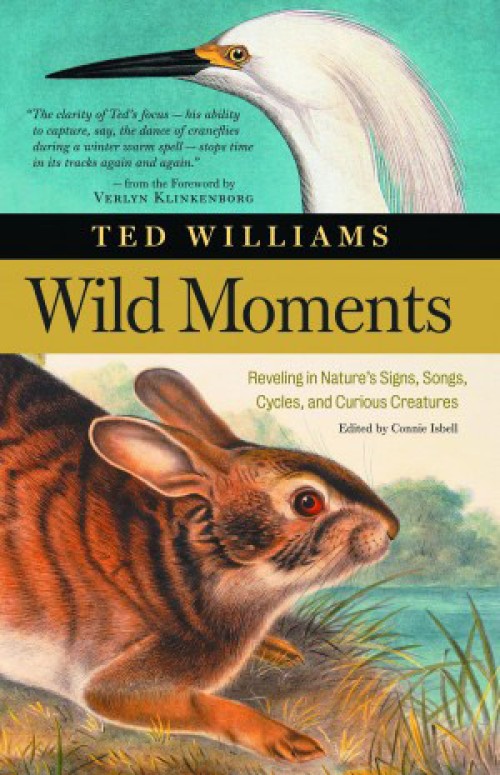by By Ted Williams
Storey Publishing, 2004
“Looking at and seeing the natural world is a skill that takes years to acquire,” Ted Williams writes in his new book, Wild Moments; and that skill is one he has developed to a high level. Whether he is writing as a naturalist or as an investigative environmental reporter in his “Incite” columns in Audubon magazine, Williams is constantly alert to the most minute detail, yet he never fails, at the same time, to take in the big picture as well. His interest, curiosity, and focus move easily from the tree to the forest and back again.
In Wild Moments, Williams the naturalist has gathered together the short essays he has been contributing since 1997 to Audubon magazine – about half a dozen per issue – under the heading “Earth Almanac.” Remaining true to its almanac origin, Wild Moments leads us through the cycle of the year – winter, spring, summer, and fall – and reveals to us, in short entries of anywhere from 100 to 300 words, wonders of the natural world that we may have looked at but not seen or, more likely, that we have overlooked altogether. Williams’s subjects range from the microscopic to the cosmic, from bugs to birds to bears to Perseid meteor showers. You can learn here how bumblebees pollinate lady’s slippers and how ants disperse trillium seeds. You can learn that moose and wolves have in their feet a highly unsaturated fat that insulates them from ice and snow and that the only winter the brown band on a woolly bear caterpillar can tell you about is the previous one, not the coming one. “The more brown hairs, the older the caterpillar. A long winter delays hatching, resulting in a younger caterpillar and a thinner band.”
But to describe Wild Moments simply as a compendium of intriguing natural lore is to sell it way too short. Williams treats us not only to his own keen observations but also to the fruits of his wide reading and research, both scientific and literary. He does not fail to tell us, for instance, that the bite of Gila monsters is poisonous but adds that they are so sluggish and reluctant to bite that they “almost require human help in the human-biting process.” Or as a Dr. Ward wrote in the Arizona Gazette of September 23, 1899: “I have never been called to attend a case of Gila monster bite, and I don’t want to be. I think a man who is fool enough to get bitten by a Gila monster ought to die.”
Then there is the writing itself. Whatever Ted Williams shows us, we see not through a glass darkly but through a glass so clear and flawless that the glass disappears entirely, and we see what Williams is seeing in all its vividness. Old squaw ducks “fly like hurricane-borne shingles”; puffins in flight “resemble badly thrown footballs.”
In short essays that introduce each of the four seasons, Williams highlights some of the things we might see in that season and adds thoughts helpful to acquiring the skill of “looking at and seeing the natural world.” In his “Spring” essay, he writes, “Never take children on ‘nature walks.’ It smacks of the teaching from which they have just been sprung. Take them on ‘expeditions’ instead, and do so with a stated purpose….Gather pussy willows, for example; build a house out of sticks and leaves; collect chrysalides; catch pollywogs. The most indelible natural-history lessons are taught by actions not words.”
True, but the next best thing to going out on an expedition with Ted Williams has to be reading his words. They alert us to what we probably missed today and will send us outdoors tomorrow better prepared to open our eyes and see.
And, as if all this were not enough, Wild Moments is a handsome book with that indispensable feature – an index – and with drawings by John Burgoyne that are as sharp and clear as Ted Williams’s prose.


